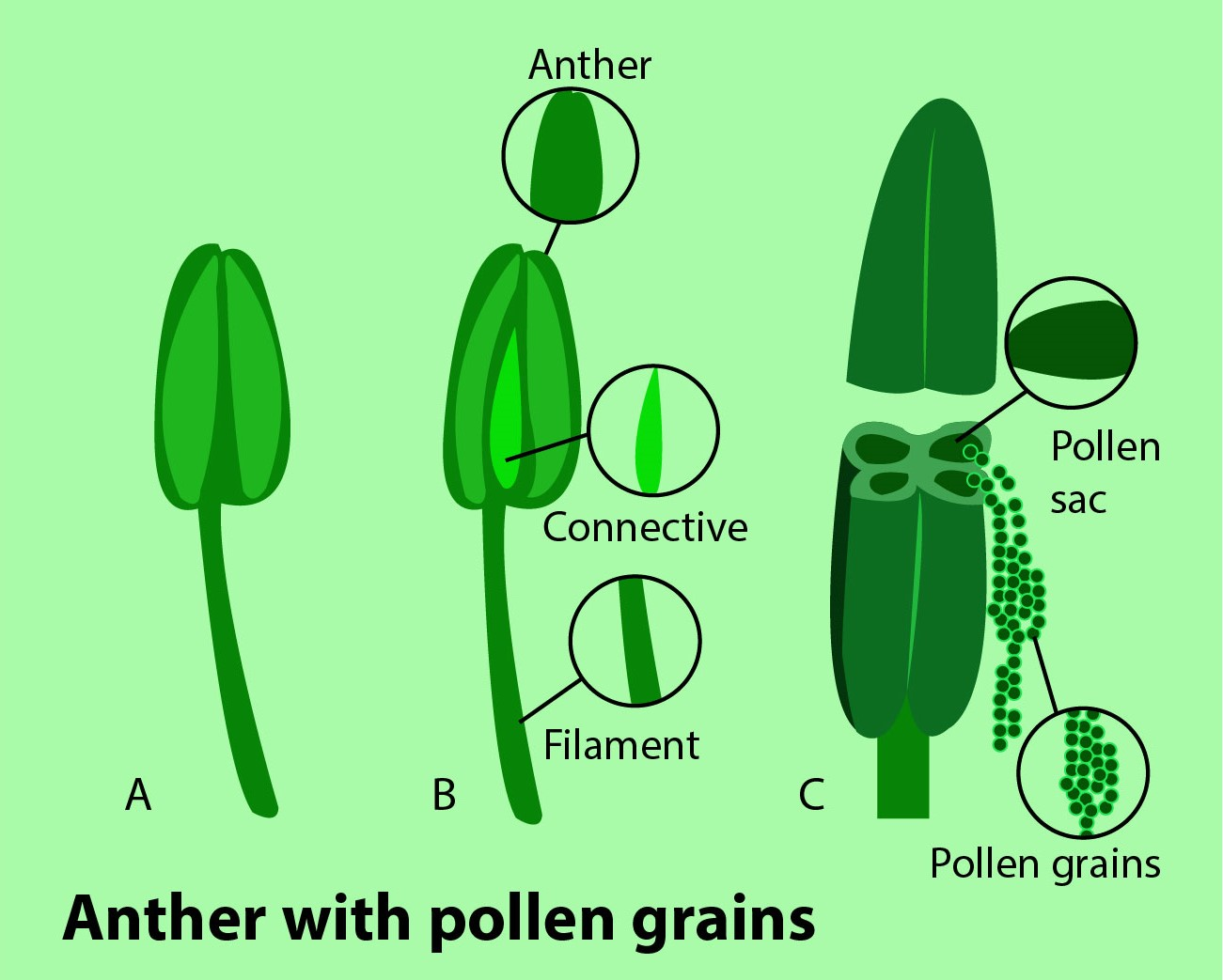
The anther contains
(a)Sepals
(b)Ovules
(c)Carpel
(d)Pollen grains
Answer
578.1k+ views
Hint: The anther of a flower contains some minute articles that are of various shapes and structures. These structures get transported to the female reproductive parts of the flower by a variety of means.
Complete answer:
An anther contains pollen grains, which enters the ovary of gynoecium and helps in sexual reproduction in plants. In the flowering plants, the pollen grains represent a reduced haploid male gametophyte generation that consists of just two or three cells when it gets released from the anthers.

Figure: Stamen; A. Ventral view; B. Dorsal view; C. Three dimensional cut section of the anther (enlarged)
Additional Information:
-Each stamen is composed of a slender stalk-like filament that supports anther. Anther is a knob-like structure with two lobes and the lobes are connected with the help of connective.
-When only one kidney-shaped anther is present then such anther is known as monothecous but if the anther contains two lobes then such anther is known as bithecous.
-When stamens are free from each other, such a condition is called polyandrous but when these are united with the stigma of the carpel, such a condition is called gynandrous.
-Sometimes, filaments of petals remain stuck with the petals, such a condition is called epipetalous while in the epiphyllous condition, stamens are attached to petals.
-When stamens are shorter than the corolla, such a condition is called inserted and when they come out of the corolla tube, such a condition is called exerted.
-In some flowers, the filament of the stamen is fixed with the base of the anther, such condition is called basifixed.
So, the correct answer is, ‘Pollen grains.’
Note: Sometimes, the stamens become sterile and do not form pollen grains called staminodes. When the connectives of anther become enlarged and the two anther lobes are separated apart called divaricated or divergent anther lobe.
Complete answer:
An anther contains pollen grains, which enters the ovary of gynoecium and helps in sexual reproduction in plants. In the flowering plants, the pollen grains represent a reduced haploid male gametophyte generation that consists of just two or three cells when it gets released from the anthers.

Figure: Stamen; A. Ventral view; B. Dorsal view; C. Three dimensional cut section of the anther (enlarged)
Additional Information:
-Each stamen is composed of a slender stalk-like filament that supports anther. Anther is a knob-like structure with two lobes and the lobes are connected with the help of connective.
-When only one kidney-shaped anther is present then such anther is known as monothecous but if the anther contains two lobes then such anther is known as bithecous.
-When stamens are free from each other, such a condition is called polyandrous but when these are united with the stigma of the carpel, such a condition is called gynandrous.
-Sometimes, filaments of petals remain stuck with the petals, such a condition is called epipetalous while in the epiphyllous condition, stamens are attached to petals.
-When stamens are shorter than the corolla, such a condition is called inserted and when they come out of the corolla tube, such a condition is called exerted.
-In some flowers, the filament of the stamen is fixed with the base of the anther, such condition is called basifixed.
So, the correct answer is, ‘Pollen grains.’
Note: Sometimes, the stamens become sterile and do not form pollen grains called staminodes. When the connectives of anther become enlarged and the two anther lobes are separated apart called divaricated or divergent anther lobe.
Recently Updated Pages
Master Class 12 Business Studies: Engaging Questions & Answers for Success

Master Class 12 Economics: Engaging Questions & Answers for Success

Master Class 12 English: Engaging Questions & Answers for Success

Master Class 12 Maths: Engaging Questions & Answers for Success

Master Class 12 Social Science: Engaging Questions & Answers for Success

Master Class 12 Chemistry: Engaging Questions & Answers for Success

Trending doubts
What is meant by exothermic and endothermic reactions class 11 chemistry CBSE

Which animal has three hearts class 11 biology CBSE

10 examples of friction in our daily life

One Metric ton is equal to kg A 10000 B 1000 C 100 class 11 physics CBSE

1 Quintal is equal to a 110 kg b 10 kg c 100kg d 1000 class 11 physics CBSE

Difference Between Prokaryotic Cells and Eukaryotic Cells




